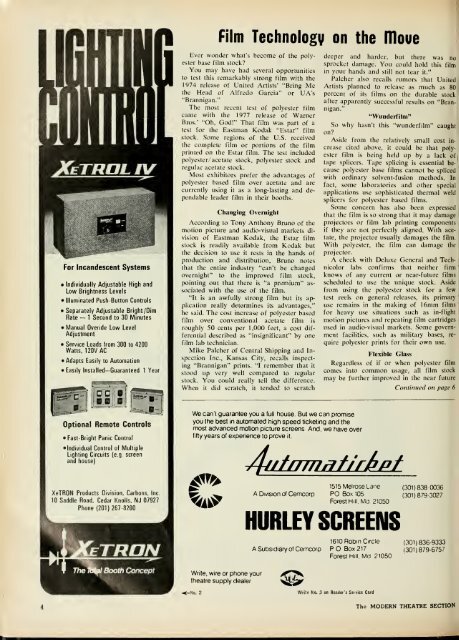You also want an ePaper? Increase the reach of your titles
YUMPU automatically turns print PDFs into web optimized ePapers that Google loves.
Film Technologv on the nioue<br />
For Incandescent Systems<br />
• Individually Adjustable High and<br />
Low Brightness Levels<br />
• Illuminated Push-Button Controls<br />
• Separately Adjustable Bright /Dim<br />
Rate — 1 Second to 30 Minutes<br />
• Manual Overide Low Level<br />
Adjustment<br />
• Service Loads from 300 to 4200<br />
Watts, 120V AC<br />
• Adapts Easily to Automation<br />
• Easily Installed— Guaranteed 1 Year<br />
Ever wonder what's become of the pwlyester<br />
base film stock<br />
You may have had several opportunities<br />
to test this remarkably strong film with the<br />
1974 release of United Artists' "Bring Me<br />
the Head of Alfredo Garcia" or UA's<br />
"Brannigan."<br />
The most recent test of polyester film<br />
came with the 1977 release of Warner<br />
Bros.' "Oh, God!" That film was part of a<br />
test for the Eastman Kodak "Estar" film<br />
stock. Some regions of the U.S. received<br />
the complete film or portions of the film<br />
printed on the Estar film. The test included<br />
polyester/ acetate stock, polyester stock and<br />
regular acetate stock.<br />
Most exhibitors prefer the advantages of<br />
polyester based film over acetate and are<br />
currently using it as a long-lasting and dependable<br />
leader film in their booths.<br />
Changing Overnight<br />
According to Tony Anthony Bruno of the<br />
motion picture and audio-visual markets division<br />
of Eastman Kodak, the Estar film<br />
stock is readily available from Kodak but<br />
the decision to use it rests in the hands of<br />
production and distribution. Bruno notes<br />
that the entire industry "can't be changed<br />
overnight" to the improved film stock,<br />
pointing out that there is "a premium" associated<br />
with the use of the film.<br />
"It is an awfully strong film but its application<br />
really determines its advantages,"<br />
he said. The cost increase of polyester based<br />
film over conventional acetate film is<br />
roughly 50 cents per 1,000 feet, a cost differential<br />
described as "insignificant" by one<br />
film lab technician.<br />
Mike Palcher of Central Shipping and Inspection<br />
Inc., Kansas City, recalls inspecting<br />
"Brannigan" prints. "I remember that it<br />
stood up very well compared to regular<br />
stock. You could really tell the difference.<br />
When it did scratch, it tended to scratch<br />
deeper and harder, but there was no<br />
sprocket damage. You could hold this film<br />
in your hands and still not tear it."<br />
Palcher also recalls rumors that United<br />
Artists planned to release as much as 80<br />
percent of its films on the durable stock<br />
after apparently successful results on "Brannigan."<br />
"Wunderfilm"<br />
,<br />
So why hasn't this "wunderfilm" caught<br />
1<br />
on<br />
Aside from the relatively small cost increase<br />
cited above, it could be that polyester<br />
film is being held up by a lack ofi<br />
tape splicers. Tape splicing is essential because<br />
polyester base films cannot be spliced<br />
with ordinary solvent-fusion methods. In<br />
fact, some laboratories and other special<br />
applications use sophisticated thermal weld<br />
splicers for polyester based films.<br />
Some concern has also been expressed<br />
that the film is so strong that it may damage<br />
projectors or film lab printing components<br />
if they are not perfectly aligned. With ace-<br />
the projector usually damages the film.<br />
tate,<br />
With polyester, the film can damage the<br />
projector.<br />
A check with Deluxe General and Technicolor<br />
labs confirms that neither firm<br />
knows of any current or near-future films<br />
scheduled to use the unique stock. Aside<br />
from using the polyester stock for a few<br />
test reels on general releases, its primary<br />
use remains in the making of 16mm films<br />
for heavy use situations such as in-flight<br />
motion pictures and repeating film cartridges<br />
used in audio-visual markets. Some government<br />
facilities, such as military bases, require<br />
polyester prints for their own use.<br />
Flexible<br />
Glass<br />
Regardless of if or when polyester film<br />
comes into common usage, all film stock<br />
may be further improved in the near future<br />
Continued on page 6<br />
Optional Remote Controls<br />
• Fast-Bright Panic Control<br />
• Individual Control of Multiple<br />
Lighting Circuits (e.g screen<br />
and house)<br />
We cant guarantee you a full fiouse But we can promise<br />
you tfie best in automated high speed ticketing and the<br />
most advanced motion picture screens And, we have over<br />
fifty years of experience to prove it.<br />
JjjiffTTn/jf/rhfjf<br />
XeTRON Products Division, Carbons. Inc.<br />
10 Saddle Road, Cedar Knolls, NJ 07927<br />
Phone (201)267 8200<br />
A Division of Cemcorp<br />
1515 Melrose Lane (301)838-0036<br />
PO Box 105 (301)879-3027<br />
Forest Hilt Md 21050<br />
HURLEY SCREENS<br />
A Subsidiary of Cemcorp<br />
1610 Robin Circle (30i) 836-9333<br />
PO Box 217 (301)879-6757<br />
Foresi Hill, fvid 21050<br />
Write, wire or phone your<br />
theatre supply dealer<br />
^fiT*^<br />
^«»8^<br />
Write No. 3 on Reader's Service Card<br />
The IVIODERN THEATRE SECTION

















